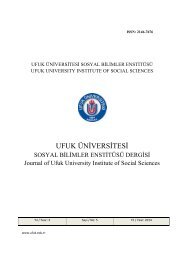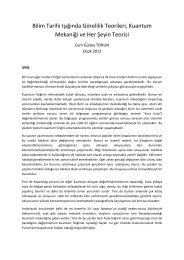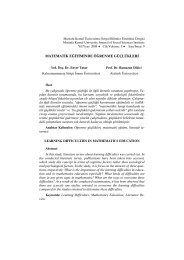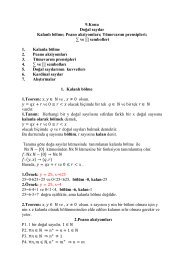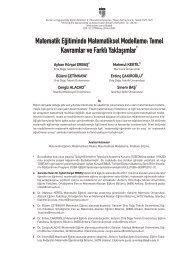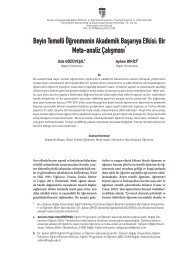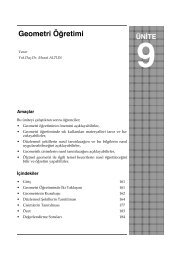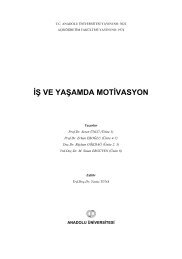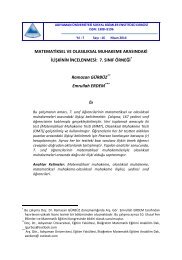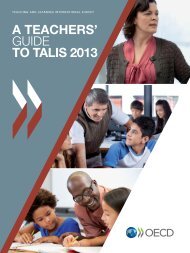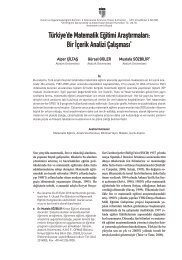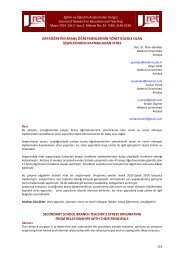bd798f7e557c386e7e231ced888acec57061
bd798f7e557c386e7e231ced888acec57061
bd798f7e557c386e7e231ced888acec57061
- No tags were found...
You also want an ePaper? Increase the reach of your titles
YUMPU automatically turns print PDFs into web optimized ePapers that Google loves.
EDUCATIONAL SCIENCES: THEORY & PRACTICE<br />
cording to Bishop (2008), decision-making lies at<br />
the heart of instructional processes; therefore, various<br />
models concerning teachers’ decision-making<br />
processes have been suggested (see Bishop & Whitfield,<br />
1972; Davies, 2004; Shavelson & Stern, 1981).<br />
Values and Teachers’ Values<br />
Value-free culture and value-free education concepts<br />
have been of particular interest until the latter<br />
half of the 20th century. Throughout this period,<br />
positive beliefs that were free from any particular<br />
social value system and formed by technological<br />
advancements and scientific explorations based<br />
on objective, rational and empirical criteria made<br />
their presence felt and the importance of moral<br />
factors were neglected. Similarly, social changes<br />
were evaluated in the lights of technological advancements<br />
rather than consequences and impacts<br />
of moral choices of social agents. Yet, this ongoing<br />
trend in thought gradually changed with the educational<br />
and socio-cultural changes and started to<br />
include value indicators (Lee, 2001). Today, the<br />
word “value” is used in different contexts for different<br />
meanings. For instance, the value of listening<br />
to a talk, the ethical value of an individual, and the<br />
value of the unknown in an equation, all have different<br />
meanings (Seah & Bishop, 2000). Swadener<br />
and Soedjadi (1988) assert that some concepts such<br />
as “good” and “bad” were needed to identify values<br />
as a concept. Raths, Harmin, and Simon (1987)<br />
define values as a general guide for the behaviors<br />
emerging from people’s relations in the real life and<br />
their experiences. Accordingly, values are an integral<br />
part of human being and they play intentional<br />
or unintentional roles on individuals’ behaviors,<br />
decisions and choices (FitzSimons, Bishop, Seah,<br />
& Clarkson, 2001). For this reason, values are<br />
influential on teachers’ decisions and behaviors<br />
(Fasheh, 1982). Gudmunsdottir (1991) regards values<br />
as a guide for teacher practice and Matthews<br />
(2001) sees them as the tools and the premises of<br />
the behavior. Clarkson (2007) states that learners<br />
observed teachers’ behaviors attentively, recognized<br />
their values and behaved accordingly. Frade<br />
and Machado (2008) report that values of teachers<br />
have a powerful effect on students’ attitudes<br />
towards mathematics, beliefs, and emotions. On<br />
the other hand, values are also handled as personal<br />
preferences and decisions associated with individual<br />
standards set for behaviors and options that<br />
seem important and valuable (Chin & Lin, 2001;<br />
Seah, 2002; Swadener & Soedjadi, 1988). Accordingly,<br />
values can be perceived as pedagogical identities<br />
of teachers as well as choices and judgments<br />
they see important or valuable according to their<br />
own pedagogical identities (Chin & Lin, 2000).<br />
Mathematics Education, Culture and Values<br />
Mathematics is generally seen as an abstract, cold<br />
and inhuman subject in the large societies, so it is<br />
associated with the views of absolutist philosophers<br />
on the one hand. On the other hand, without rejecting<br />
the role of mathematical structure, fallibist<br />
philosophers assert that mathematics is value-laden<br />
and culture laden (Bishop, 2002; Ernest, 2007).<br />
Hence, these two different points of view related<br />
to mathematical philosophy typically have different<br />
effects on classroom practices (Ernest, 1991)<br />
and teachers’ values affect teaching approaches<br />
they adopt (see Seah, 2003a). In this respect, it is<br />
important to determine teachers’ value preferences<br />
for their instructions and to reveal their awareness<br />
on values they have (Chin, 2006). Culture stands as<br />
a powerful determiner of mathematical values and<br />
different cultures possess different values (Seah,<br />
2003b). There is no consensus about the definition<br />
of the concept “culture”. However, many people<br />
have a general understanding of what culture is and<br />
what it requires. In this sense, culture consists of<br />
values, beliefs, and concepts shared within a society<br />
(Venaik & Brewer, 2008). In the study of Kroeber<br />
and Kluckhohn (1952), one of the classical sources,<br />
it was noted that traditional concepts (e.g., concepts<br />
derived and selected in a historical process)<br />
and related values generate the essence of culture.<br />
Therefore, mathematics teachers who work in different<br />
cultures do not teach the same values to their<br />
students, even if they have taught the same curriculum<br />
(Bishop, Clarkson, FitzSimons, & Seah, 2000).<br />
For example, the value of “technology” may be an<br />
important value in mathematics education within<br />
an education system while it may not be important<br />
at all within another education system (Atweh &<br />
Seah, 2008). For this reason, National Council of<br />
Teachers of Mathematics [NCTM] (2000) regards<br />
mathematics as a part of the cultural heritage and<br />
saw it as one of the most important cultural and intellectual<br />
accomplishments of human brain. Prediger<br />
(2001) characterizes mathematics as a “cultural<br />
phenomenon” (p. 23). In a similar vein, in German<br />
Primary Mathematics Program (RGM, 2004), it is<br />
noted that mathematical concepts and methods are<br />
developed in a historical process in line with the<br />
problems of social and practical circumstances and<br />
teachers are required to teach by considering these<br />
individual, societal, and cultural events.<br />
692





